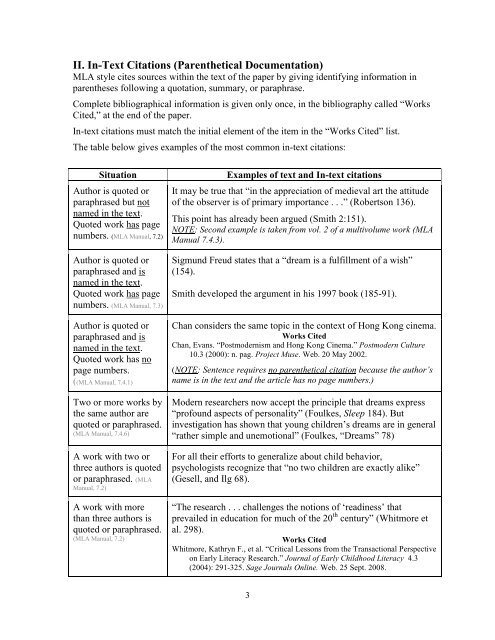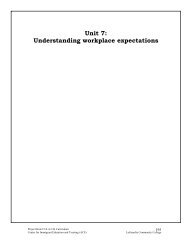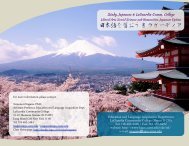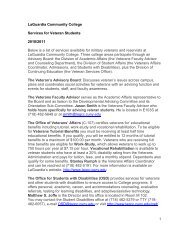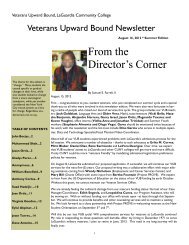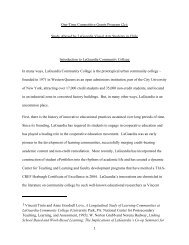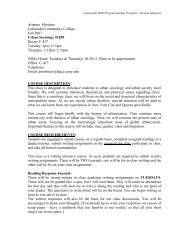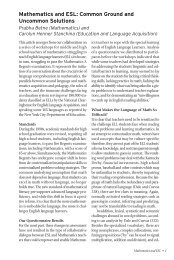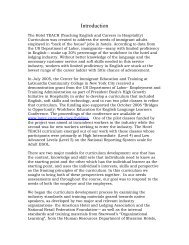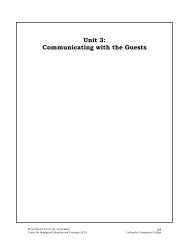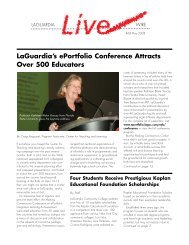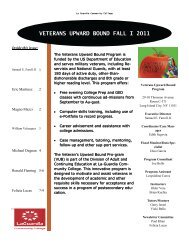MLA In-Text Citation and Works Cited Entries - LaGuardia ...
MLA In-Text Citation and Works Cited Entries - LaGuardia ...
MLA In-Text Citation and Works Cited Entries - LaGuardia ...
Create successful ePaper yourself
Turn your PDF publications into a flip-book with our unique Google optimized e-Paper software.
II. <strong>In</strong>-<strong>Text</strong> <strong>Citation</strong>s (Parenthetical Documentation)<br />
<strong>MLA</strong> style cites sources within the text of the paper by giving identifying information in<br />
parentheses following a quotation, summary, or paraphrase.<br />
Complete bibliographical information is given only once, in the bibliography called “<strong>Works</strong><br />
<strong>Cited</strong>,” at the end of the paper.<br />
<strong>In</strong>-text citations must match the initial element of the item in the “<strong>Works</strong> <strong>Cited</strong>” list.<br />
The table below gives examples of the most common in-text citations:<br />
Situation<br />
Author is quoted or<br />
paraphrased but not<br />
named in the text.<br />
Quoted work has page<br />
numbers. (<strong>MLA</strong> Manual, 7.2)<br />
Author is quoted or<br />
paraphrased <strong>and</strong> is<br />
named in the text.<br />
Quoted work has page<br />
numbers. (<strong>MLA</strong> Manual, 7.3)<br />
Author is quoted or<br />
paraphrased <strong>and</strong> is<br />
named in the text.<br />
Quoted work has no<br />
page numbers.<br />
((<strong>MLA</strong> Manual, 7.4.1)<br />
Two or more works by<br />
the same author are<br />
quoted or paraphrased.<br />
(<strong>MLA</strong> Manual, 7.4.6)<br />
A work with two or<br />
three authors is quoted<br />
or paraphrased. (<strong>MLA</strong><br />
Manual, 7.2)<br />
A work with more<br />
than three authors is<br />
quoted or paraphrased.<br />
(<strong>MLA</strong> Manual, 7.2)<br />
Examples of text <strong>and</strong> <strong>In</strong>-text citations<br />
It may be true that “in the appreciation of medieval art the attitude<br />
of the observer is of primary importance . . .” (Robertson 136).<br />
This point has already been argued (Smith 2:151).<br />
NOTE: Second example is taken from vol. 2 of a multivolume work (<strong>MLA</strong><br />
Manual 7.4.3).<br />
Sigmund Freud states that a “dream is a fulfillment of a wish”<br />
(154).<br />
Smith developed the argument in his 1997 book (185-91).<br />
Chan considers the same topic in the context of Hong Kong cinema.<br />
<strong>Works</strong> <strong>Cited</strong><br />
Chan, Evans. “Postmodernism <strong>and</strong> Hong Kong Cinema.” Postmodern Culture<br />
10.3 (2000): n. pag. Project Muse. Web. 20 May 2002.<br />
(NOTE: Sentence requires no parenthetical citation because the author’s<br />
name is in the text <strong>and</strong> the article has no page numbers.)<br />
Modern researchers now accept the principle that dreams express<br />
“profound aspects of personality” (Foulkes, Sleep 184). But<br />
investigation has shown that young children‟s dreams are in general<br />
“rather simple <strong>and</strong> unemotional” (Foulkes, “Dreams” 78)<br />
For all their efforts to generalize about child behavior,<br />
psychologists recognize that “no two children are exactly alike”<br />
(Gesell, <strong>and</strong> Ilg 68).<br />
“The research . . . challenges the notions of „readiness‟ that<br />
prevailed in education for much of the 20 th century” (Whitmore et<br />
al. 298).<br />
<strong>Works</strong> <strong>Cited</strong><br />
Whitmore, Kathryn F., et al. “Critical Lessons from the Transactional Perspective<br />
on Early Literacy Research.” Journal of Early Childhood Literacy 4.3<br />
(2004): 291-325. Sage Journals Online. Web. 25 Sept. 2008.<br />
3


